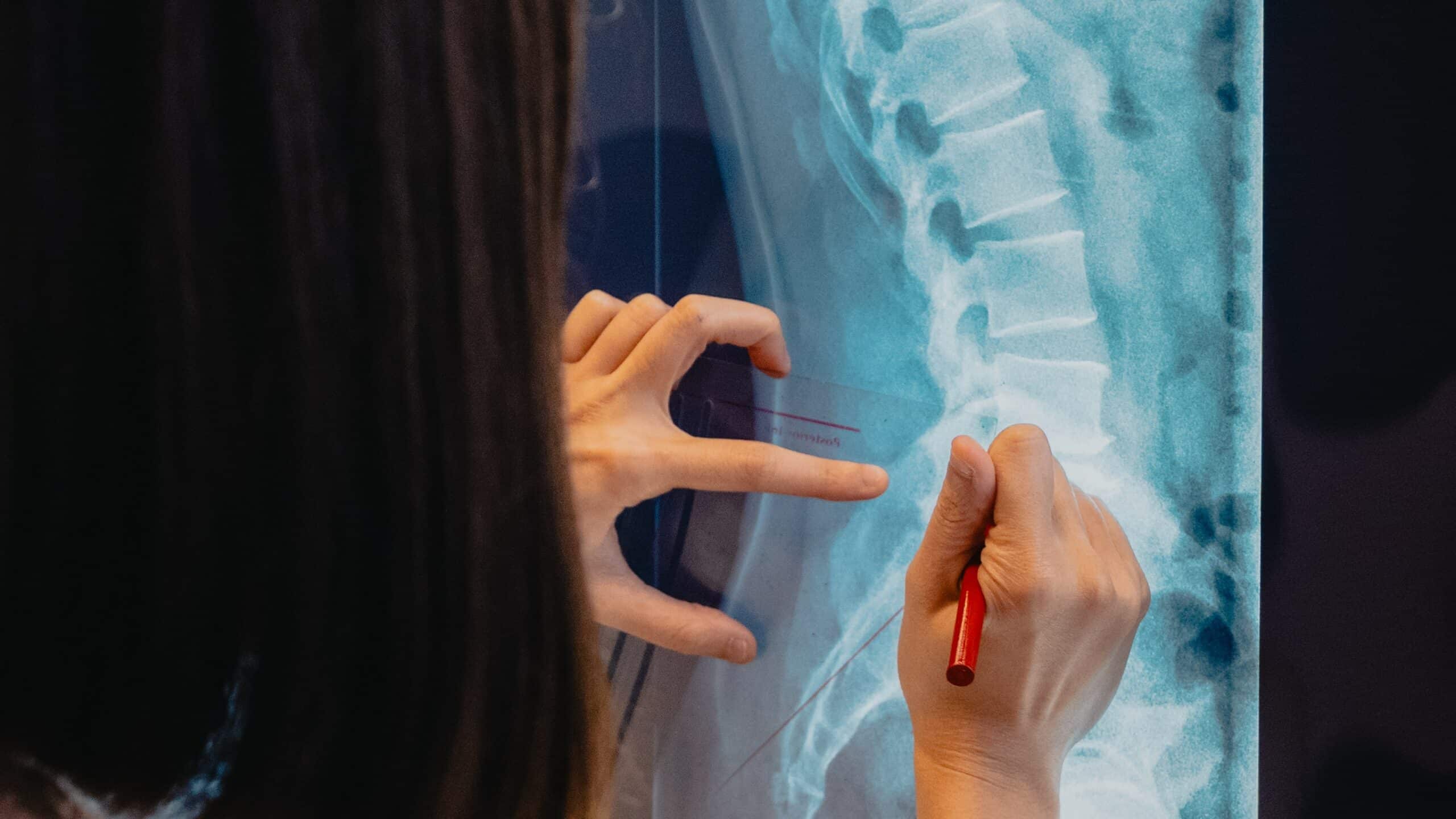Do you suffer from persistent back pain? Are over-the-counter pain meds becoming a regular part of your routine filling the void in relief?
You may be suffering from spinal cord compression! Spinal cord compression is a serious health issue that can cause pain, numbness, and other symptoms. If left unaddressed, spinal cord compression can have serious repercussions on your quality of life.
Fortunately, chiropractic care provides a safe and effective way to reduce inflammation and relieve pain while providing long-term relief from the symptoms of spinal cord compression. This is done through spinal decompression therapy, which helps to alleviate pressure on the spinal discs by stretching them gently and allowing for optimal healing.
Read on as we share more about the causes and symptoms of spinal cord compression as well as how chiropractic care, specifically spinal decompression, can help to manage it!
What is spinal cord compression?
Spinal cord compression is a condition which occurs when spinal nerves or the spinal cord itself get compressed due to injury, degenerative conditions, spinal stenosis, spinal arthritis, or tumours. This can cause pain, numbness and other symptoms depending on the severity of the compression.
What are some causes of spinal cord compression?
The most common causes of spinal cord compression include:
- Spinal stenosis – Spinal stenosis is a narrowing of the spinal canal, which can compress the spinal nerves and lead to pain, numbness and other symptoms.
- Spinal arthritis – Spinal arthritis is a degenerative joint disease that affects the spine, causing inflammation and stiffness as well as narrowing of the spinal canal.
- Tumours – Tumours can also put pressure on spinal nerves, causing spinal cord compression and related symptoms.
In addition, poor posture and slouching are also rapidly becoming a significant source of spinal cord compression. When we slump or hunch our shoulders, the ligaments in our spine can become overstretched, leading to painful disc strain. This leads to spinal cord compression because spinal nerves can become pinched when the spinal disc is compressed.
What are some symptoms of spinal cord compression symptoms?
The most common symptoms of spinal cord compression are pain, numbness, tingling and muscle weakness in the affected area. This can range from mild to severe depending on the amount of compressing occurring. Other symptoms include a feeling of discomfort or heaviness in the area and difficulty walking or doing other activities.
Suffering with spinal cord compression can therefore greatly impede you from living a normal and pain-free life, inhibiting you from doing what you love.
How serious is spinal cord compression?
Spinal cord compression is a very serious condition and should not be taken lightly. If left unaddressed, spinal cord compression can lead to intense pain that may even become chronic in nature. It can also cause permanent nerve damage if the spinal nerves are compressed for too long.
Seeking treatment early also means that you are able to return to living your life to the fullest as soon as possible! Read on as we discuss some methods for spinal cord decompression.
What is spinal decompression and how does it address spinal cord compression?
Spinal decompression is designed to reduce spinal cord compression. This is done through surgical or non-surgical means, both of which works on the spinal column to reduce spinal nerve compression, allowing for more room between vertebrae and relieving pressure on spinal nerves.
What are the differences between surgical & non-surgical spinal decompression?
The difference between surgical and nonsurgical spinal decompression is the level of invasiveness required to relieve spinal cord compression. Surgical spinal decompression involves spinal surgery to remove bone or disc material that may be pinching spinal nerves, while non-surgical spinal decompression uses targeted manual therapy to help reduce pressure on the spine.
Who are recommended for non-surgical spinal decompression approaches?
Non-surgical spinal decompression can involve traction therapy, which stretches and relaxes muscles around the spine; electrical stimulation, which helps with muscle relaxation; and manual manipulation of soft tissue.
Non-surgical spinal decompression approaches are typically recommended for people who have:
- Recent injuries from occupational accidents or auto accidents
- Degenerative disc disease
- Chronic neck or lower back pain
- Vertebral subluxation complex resulting from misalignment of vertebrae bones
- Herniated discs without nerve involvement
- Sciatica without radiculopathy (nerve impingement)
- Facet syndrome (inflammation of facets joints)
- Post-surgery spinal pain
- Spinal stenosis
Chiropractic care is an effective non-surgical spinal decompression approach
Chiropractic care is becoming an increasingly popular option for spinal cord compression due to its effectiveness in helping to reduce inflammation and relieve pain while providing lasting relief from the symptoms. It can be used as a spinal decompression technique without the need for surgical intervention or medications.
Why is non-surgical spinal decompression safer?
Non-surgical spinal decompression is safer than surgical spinal decompression as it does not involve any major invasive procedures. Non-surgical spinal decompression also carries less risk of complications and side effects, meaning that you can return to normal activities quickly and without a long recovery period.
Plus, chiropractic care works as it helps to improve spinal mobility and reduce nerve interference, so you can be sure that you’ll get relief from the pain and discomfort of spinal cord compression in a safe and natural way.
How does chiropractic spinal decompression therapy work?
Chiropractic spinal decompression therapy involves gently stretching the spinal discs to reduce their compression and allow for better healing, improved posture, and increased blood flow to the spinal cord. The spinal decompression therapy helps to reduce nerve root pressure and can help to alleviate pain in the affected area, while promoting spinal health and mobility.
Chiropractors are trained to provide spinal decompression therapy that is tailored to each individual’s needs. Before beginning spinal decompression therapy, your chiropractor will evaluate your spinal health and discuss with you the best approach to take.
Spinal decompression therapy can be used in combination with other forms of chiropractic care, such as spinal manipulation and spinal mobilisation, to reduce spinal cord compression and help alleviate pain. Chiropractors also recommend lifestyle changes, such as regular exercise and proper posture, to help with spinal cord compression.
In short, Chiropractic spinal decompression therapy is a safe and effective way to relieve spinal cord compression pain and provide long-term relief from symptoms.
Why choose Chiropractic Singapore for your spinal decompression management?
At Chiropractic Singapore, we are committed to providing an individualised spinal decompression therapy approach that is tailored to each patient’s needs. Our team of experienced chiropractors offers safe and effective spinal decompression adjustments that are designed to reduce spinal cord compression and promote spinal health.
We also provide lifestyle advice and guidance on spinal cord compression, as well as postural and ergonomic advice to help you maintain spinal health. If you’re looking for an effective spinal decompression adjustment in Singapore, trust Chiropractic Singapore to provide the best solution for your needs.
Book an appointment with one of our experienced chiropractors and start your spinal decompression journey!
FAQs of spinal cord compression & spinal decompression therapy
Can I solve spinal compression on my own?
It is not recommended to address spinal cord compression on your own. Chiropractic spinal decompression therapy is the safest and most effective way to reduce spinal cord compression pain and help provide lasting relief from symptoms.
With that said, here are some exercises to help ease the symptoms of spinal compression:
Pelvic-focused exercise
- Begin by reclining on your back with both knees bent and feet firmly planted on the floor. Notice how your lower back has an arch in this position.
- Next, press down hard to flatten out that curve in your spine, then relax.
- Repeat these steps rapidly for 30 seconds while aiming to reach 30 repetitions of the movement all together!
Knees-focused exercise
- Bring each knee up to your chest one at a time until both thighs are level with the ground.
- Cross your ankles and let your knees drop outwards, then hold them by wrapping both hands around each thigh so that all of the weight from below rests in your palms.
- Gently rock back-and-forth for 30 seconds as if you were cradling an infant – this should be done rhythmically for maximum relaxation benefits!
Using a block on your back
- To begin the exercise, lie on your back with both feet flat against the floor and knees bent. Then gently lift your pelvis off of the ground to place a block or pillow lengthwise at your sacrum (the hard bone located just above your tailbone).
- Keeping both arms straightened out by your sides, gradually extend each leg until you are completely relaxed in this position for no more than one minute. It is normal to experience some discomfort during this adaptation period as you settle into position.
- After spending a minute of lying across your back block, cautiously bring your arms down to their original placement.
- Then with mindful attention, return each leg one at a time to the beginning position (this may be uncomfortable).
When should I do spinal decompression exercises?
We accumulate compression in our spines throughout the day, making an evening routine ideal. You can do this as many times as you want; however, it is not recommended to begin immediately upon waking since your body has already decompressed during sleep. To maximise its effectiveness, perform this routine before going to bed for the night.
However, do note that these exercises can provide some relief but they do not directly tackle the root cause of the issue and the pain may persist the next day.
What are lifestyle changes I can make to improve my spinal cord compression?
Besides spinal decompression treatments, you can improve spinal cord compression by making simple lifestyle changes.
- Regular stretching: Stretching daily helps to reduce spinal cord compression and improve flexibility. Make sure you stretch regularly with movements that target the muscles around your spinal column such as neck rolls, shoulder shrugs and back extensions.
- Good posture: Poor posture has been linked to spinal cord compression. Make sure you sit up straight with both feet planted firmly on the floor, your thighs and hips at a 90-degree angle and your shoulders comfortably back.
- Regular exercise: Exercise has many benefits, including reducing spinal cord compression. Regularly participating in moderate physical activity can help improve spinal flexibility and strengthen the muscles around your spinal column, reducing symptoms of spinal cord compression.
The importance of addressing spinal cord compression early
In conclusion, spinal cord compression is a serious health issue that can cause pain, numbness and other symptoms and it is therefore important to catch it early. Chiropractic care is one of the best non-surgical options available for spinal cord compression, helping to reduce inflammation and relieve pain while providing long-term relief from spinal cord compression symptoms.
If you are experiencing any of the symptoms of spinal cord compression, don’t wait. Book a spinal check-up with us today so we can help you find relief from your pain!








